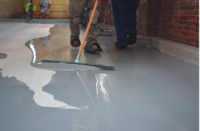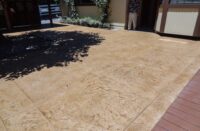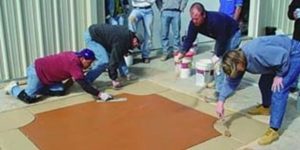
When selling a job, there shouldn’t be any gray areas about the maintenance of colored concrete. Educating clients about maintaining the application and managing their expectations for the future begin during the sale, say veteran troubleshooters in the industry.
“It comes down to communication between the contractor and the client,” says Chris Sullivan, national sales manager for QC Construction Products.
Colored concrete comes with a different set of expectations than gray flatwork, he says. Homeowners who write hefty checks will give it more scrutiny. Commercial customers consider it part of a business’s identity, and want the most for their money. As a prominent feature on the property, the application will serve as a showpiece —
or a black eye — for the applicator and the industry as a whole. How the appearance holds up will in large part determine whether the work serves as good or bad publicity.
Sullivan says that he’s learned from troubleshooting hundreds of installations that too many contractors fail to address maintenance as part of selling and finishing the job. The client needs this information, in writing, from the start, he says.

when the decorative concrete floor is installed, the wax will require
periodic reapplication after a thorough scrubbing and cleaning.
Clark Branum, western division training and support manager for L.M. Scofield Co., offers similar advice. “Maintenance should always be addressed during the planning phase through front-end work,” he says. “The client needs to know the durability of the selected sealers or waxes, and also needs to be given proper maintenance guidelines to work with. This can be done during the hand-over and final walk-throughs.”
“(During the walk-through,) they should be handing out written guidelines in a complete maintenance package,” Sullivan says.
What that maintenance package entails depends on whether the application is interior or exterior, polished, textured or stained, and how it was sealed. Homeowners and businesses can adopt some routine maintenance tasks that will promote the longevity of their colored applications.
If the application is on the floor, Sullivan says that owners should put down walk-off mats at entrances and exits, especially in commercial applications. That’s where traffic concentrates and grit collects underfoot like sandpaper. Then sweep, mop with soap and water, and rinse clean. It’s that simple. Most floors need it daily regardless of the material.
Sealers
The next level of maintenance, resealing, can be done by the client or hired maintenance contractor. The decorative concrete contractor is not responsible for resealing, but he or she is responsible for educating the client on the topic. Some applicators are selling long-term maintenance contracts with the jobs, and much of the work involves resealing.
“The frequency depends on the use and the type of sealer used,” Branum says. Most exterior sealers are acrylic-based, and the quality of the acrylic resins will vary by manufacturer, he says. Some things to look for in a sealer include UV inhibitors for protection from sun exposure. “Not only does this protect the colored concrete surface, but it also protects the acrylic film from UV breakdown,” he says.
In lightly used areas, good quality acrylic films should stand up one to two years before needing a recoat. In high traffic commercial areas, annual or biannual recoats may be required. “Acrylic-urethane blends tend to work better than standard acrylics, because they offer greater chemical resistance and improved abrasion resistance,” Branum says.

Even if it’s not a strong profit center, a maintenance division is a way for a company to ensure that applications continue to speak well for themselves. “Some companies have maintenance divisions now that specialize in cleaning and resealing textured concrete and pool decks,” says Branum.
If neglected, dirt and grit tend to accumulate in the textured surface of stamped concrete, so it should be kept clean in order to prevent the growth of fungus or moss. Depending on the sun exposure and the rate of wear, the color may require touch-up when it is resealed, Branum says.
When it comes to exterior stain work, Steve Schmid, owner of Stone Touch Inc. in Salt Lake City, provides customers with a maintenance manual, some training, and even the sealers. “I’m willing to sell them the products at cost. I just want to keep them happy and recommend us to their friends.”
On stained interior floors, Schmid used to recommend wax products, provide a maintenance program and hope that the customer followed through. But now Stone Touch is in a win-win business relationship with a maintenance company. When the installation is finished, Schmid turns the floor over to a maintenance team from Waxie Sanitary Supply. Waxie, a janitorial company that operates in the Western states, sends in a training team to set the customer up with a maintenance program using Waxie’s products. There is no cost to the contractor, but it enables Schmid to guarantee his work as long as the customer follows the maintenance program.
“Honestly, it makes us look better,” Schmid says. “And if there is a problem, we know exactly what they’ve done and have not done with it, and we know exactly how to take care of it.” Schmid says callbacks have dropped by 75 percent since he started the program.
Not fade away
Applications with integral colors may benefit the most from customer education and periodic maintenance. Sullivan points out that the color of exterior surfaces will change over time as the iron oxide pigments get dirty, and it’s important to teach customers that the original color hasn’t faded — it’s still there. A good cleaning and resealing will restore bright colors to their original tones, Sullivan says. He suggests that contactors offer a maintenance contract with the integral-color installation, so that it keeps the artisan looking good.















